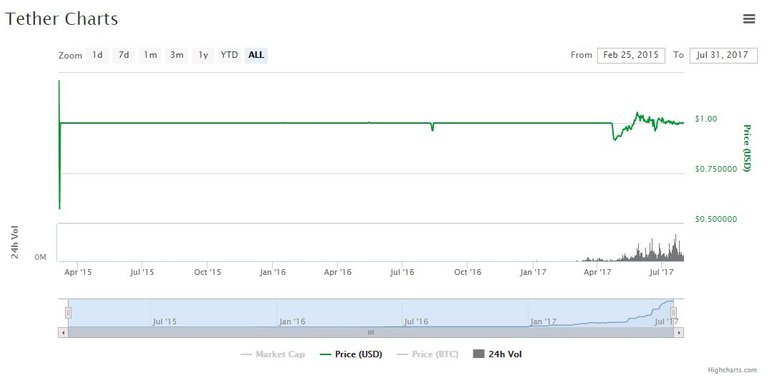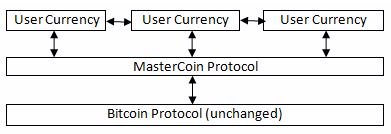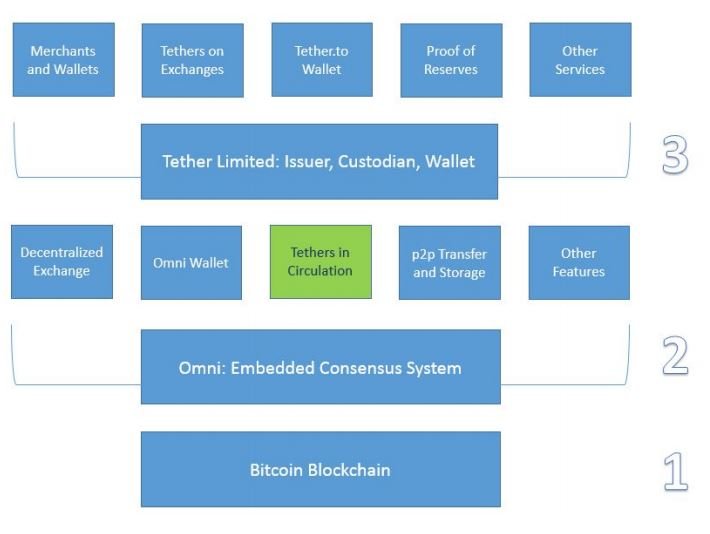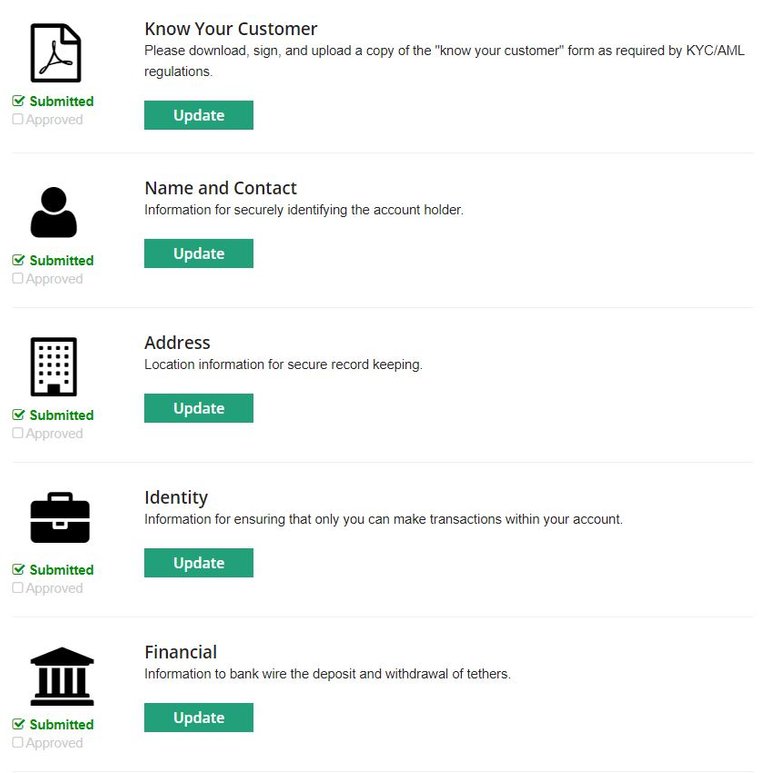
Store of Value
When investors face uncertainty or high volatility they move their assets to a holding that is not affected by the rest of the market. This is a fundamental strategy in all existing markets. Other times, when a desired return or profit is met, it gets captured in the form of a cash settlement. In the cryptosphere, this is typically done by comparing returns to the amount of Bitcoin Satoshi's a coin has gained, exchanging the coin for the equivalent amount of Bitcoin, and finally converting the Bitcoin to fiat.
Currently, cashing out to fiat is a time consuming process that takes days to complete. This means if an investor wants to get back into the crypto market they must again wait days for their fiat to clear the traditional bank payment channels. Also, most exchanges do not offer a market for trading into fiat currency and those that do (and comply with regulation laws) require verification to follow KYC and AML laws. The best known example of this is Coinbase, one of the more reliable sources of entry into the crytpo market (fiat to BTC/ETH/LTC). Coinbase also allows users to hold fiat in their account for instant access to trading. However, the recent shuttering of BTC-e, and many other exchanges before it, proves crypto traders should not trust any exchange with excess amounts of their holdings (i.e. keep the amount of coins held in an exchange wallet to a minimum).
If traders settle in Bitcoin and HODL it as their store of value, this realizes BTC profits/losses but still leaves traders vulnerable to the volatility of Bitcoin. Again, Coinbase offers a USD wallet but only offers 3 coins to transact with and also would require a fee to move profits into and out of wallets or exchanges. This is where the utility of a fiat pegged cryptocurrency becomes obvious. No one can predict the rise and fall of a market but when a trader hits their preferred level of profit/loss then a settlement mechanism is required. Tether aims to do just that: allow traders to convert their cryptocurrencies into a stable token providing protection against market volatility.
Fiat Pegged Cryptocurrency
This concept is likely already familiar for those trading cryptocurrencies on an exchange that offers a trading pair with Tether. Put simply, Tether is a cryptocurrency that is pegged directly to that of Fiat currency because each coin is directly backed with the matching amount of fiat currency (one-to-one). The currencies currently offered for trade with Tether are US Dollars (USD), Euros (EUR), and Japanese Yen (JPY) and on exchanges are found under the symbols USD₮, EUR₮, and JPY₮ respectively.
The goal for each of these coins is to remain equal in value to that of the underlying fiat currency. For more insight on previously failed attempts at pegged cryptos please read Larry White's article on this topic. As you can see in the following graph, Tether had been performing their task remarkably well until the most recent cryptocurrency run up (some may call it a bubble), but it never strayed to far away from the $1 USD to 1 USD₮ ratio.
One might ask how does this work and why should I trust it? The coin exists on top of the Bitcoin network, meaning it has a large, established backing, and the company behind it holds a line of credit with two banks in Asia that are cryptocurrency friendly. Another positive step towards trust is their level of transparency. You can see how much reserve Tether holds and how many tokens are in circulation at https://wallet.tether.to/transparency. While audit results are not shared and further detail on how the liabilities are managed are not present, it provides a snapshot into how tightly coupled (or not) Tether is tied to the Fiat underlying.
Omni Protocol - Powered by Bitcoin Blockchain
From the MasterCoin white paper the Omni Protocol was born. The Omni Protocol is designed to be a layer between the existing Bitcoin Protocol and users' currencies. It is a basic tool that allows anyone to design and release their own currency with their own rules, without any software development (sounding very similar to ERC20 tokens isn't it?). The technical walkthrough can be found on the Omni Layer GitHub. In short this takes advantage of the little known function on the Bitcoin Blockchain that allows for scripting using the OP_RETURN to create a provably prune-able output to avoid blockchain bloat. The layer can easily be visualized like the following:
Proof of Reserve
In their current form, exchanges are unreliable and insolvency is always right around the corner due to hacks, mismanagement, or outright fraud. It requires everyone to be diligent with their use of each exchange and puts a heavy burden on each user to properly manage their various wallets and keys. Tether Limited seeks to eliminate this risk by introducing the Proof of Reserve concept. The PoR is a process that ensures the number of tethers in circulation are fully backed by an equal amount of fiat currency. The verification process of this one-to-one fiat backing is trivial since the number of tethers in circulation can be queried from the blockchain (or viewed at omnichest.info) and the amount of fiat currency is transparent on the tether.to website.
To better understand how this process works, the Tether Limited white paper provides the following graphic to help demonstrate how funds are accounted for. In its most basic form, when 1 tether is issued, $1 USD is reserved from one of the partner banks and when 1 tether is redeemed for fiat the tether is destroyed and $1 USD is sent to the user's bank account.
Tether Stack
Much like Ethereum is attempting to build a stack of decentralized applications, the Omni Layer protocol does a similar function on the Bitcoin blockchain. The layers of the stack for Tether are as follows:
- Bitcoin Blockchain
- Omni Layer Protocol
- Tether Limited (primary business entity)
As you move up the stack each layer provides more abstraction away from the underlying blockchain and eventually ends with a customer facing business that functions like any other business. In this case the business, Tether Limited, is audited and follows strict KYC and AML guidelines to open an account and interact with their wallet service.
Verification Process
In order to use the tether.to wallet it is required to get verified. We are sure that this could be controversial for those that want to remain anonymous and for those willing to go through the process this still remains a large hurdle to adoption of this wallet based on the number of steps required. Here is a snapshot of the verification steps required.
This is necessary because, as the seizure of BTC-e has shown, any business that interacts with USD or is transacting with US banks is required to adhere to US law. Otherwise the business will be in violation of the law and subject to stiff penalties. Again, this is not a cryptocurrency or blockchain regulation, this is a requirement when dealing with USD and US bank accounts. Another option businesses have is to not offer services to US customers which is increasingly problematic in the current digital age.
Wallets
Official Tether wallets are offered online via a web portal at tether.to. There is also an option to download a mobile app to store USDT. If using this method, it is then possible to transfer these funds back to an insured bank account or to another exchange for use.
Another added benefit of using the Omni Layer Protocol is the ability to use an Omni Layer enabled wallet and the Omni Layer website presents a couple of options. The one downside is having to store the entire blockchain if using the fully-validating desktop wallet. Another option is something like Holy Transaction which allows for exchange between currencies inside the wallet (similar to the exodus wallet, but not going through ShapeShift).
Pro's and Con's
The advantages to having a coin backed by the most popular and secure blockchain on the market (Bitcoin) are clear. Tether’s ability to remove volatility from crypto holdings is also a plus. Finally, there are low to no fees, differentiation when compared to other pegged proposals, and open criticism and weaknesses as covered in the Tether Limited white paper.
While Tether is not fiat, it is also not a cryptocurrency investment. It is designed to always be worth $1, €1, or 1 unit of the underlying currency.
Fees
These are incredibly low when compared to other options out there and one major benefit is that once it is in a Tether Wallet there are no fees to transfer (this may not be true once on an exchange).
Benefits
- Tethers exist on the Bitcoin blockchain rather than a less developed/tested “altcoin” blockchain nor within closed source software running on centralized, private databases.
- Tethers can be used just like bitcoins, i.e. in a p2p, pseudo-anonymous, decentralized,
cryptographically secure environment. - Tethers can be integrated with merchants, exchanges, and wallets just as easily as Bitcoin or any other cryptocurrencies can be integrated.
- Tethers inherit the properties of the Omni Layer protocol which include: a decentralized exchange; browser based, open source, wallet encryption; Bitcoin-based transparency, accountability, multiparty security and reporting functions.
- Tether Limited employs a simple but effective approach for conducting Proof of Reserves which significantly reduces our counterparty risk as the custodian of the reserve assets.
- Tether issuance or redemption will not face any pricing or liquidity constraints. Users can buy or sell as many tethers as they want, quickly, and with very low fees.
- Tethers is unlikely to face market risks such as Black Swan events, liquidity crunches, etc as reserves are maintained in a one-to-one ratio rather than relying on market forces.
- Tether’s one-to-one backing implementation is easier for nontechnical users to understand as opposed to collateralization techniques or derivative strategies.
Implementation Weaknesses
- Bankruptcy
- In this case, the business entity Tether Limited would go bankrupt but client funds
would be safe, and subsequently, all tethers will remain redeemable. Most security breaches on Bitcoin businesses have targeted cryptocurrencies rather than bank accounts. Since all tethers exist on the Bitcoin blockchain they can be stored by individuals directly through securing their own private keys.
- In this case, the business entity Tether Limited would go bankrupt but client funds
- Banks backing Tether Limited go insolvent
- This is a risk faced by all users of the legacy financial system and by all exchange operators. Tether Limited currently has accounts with Cathay United Bank and Hwatai Bank in Taiwan, both of whom are aware and confident that Tether’s business model is acceptable. Additional banking partners are being established in other jurisdictions to further mitigate this concern.
- The bank could freeze or confiscate Tether Limited funds
- Tether’s banks are aware of the nature of Bitcoin and are accepting of Bitcoin businesses. They also provide banking services to some of the largest Bitcoin exchanges globally. The KYC/AML processes Tether follow are also used by the other digital currency exchanges they currently bank.
- Tether Limited absconds with the reserve assets
- The corporate charter is public as well as the business owners names, locations, and reputations. Ownership of the account is legally bound to the corporate charter. Any transfers in or out of the bank account will have the associated traces and are bound by rigid internal policies.
- Recentralization of risk to a single point of failure
- Tether Limited has some ideas on how to overcome this and they will be sharing them in upcoming blog and product updates. There are many ways to tackle this problem. For now, this initial implementation gets us on the right track to realize these innovations in following versions. By leveraging the platforms we have chosen, we have reduced the centralization risk to one singular responsibility: the creation and redemption of tokens. All other aspects of the system are decentralized.
Conclusion
We hope that this helps introduce what Tether is and how you can start using it for protection against volatility. We plan to investigate how it can also help indicate market sentiment, but in such an early phase it may prove difficult to tease out this significance.
Tip Jar
- Bitcoin - 1CFSxj1dy4a9B4ZYwvDmdds8zB3unNSW2t
- Litecoin - LZxBp3QAZ2SDheN8FaRVHg4nuWPnWAQSdP
- Ethereum - 0x009561fC7CF8656c53EB0874c601DC359E40f76f
- NEO - ANwvg4giWPxrZeJtR3ro9TJf4dUHk5wjKe
- Dash - XkAGSD83Mb9TD4whTeJ6SQawBh56WjwUEM
- Ripple - rEfV4j3Jhzj1BW8948ePHTPEnqCf9cxt7w
- IOTA - YMPFQWXQYHT9DDJVGDGY9SNCSB9F999UDAVWLGXGEIBPHUXJYHQDVWMFFWCTSUTMIUDFNQIBUTQUJGSWZCKMHUOKTB






Wow! Super indepth review of Tether! I was curoius about it and that Omni Layer protocal seems very versatile.
Are you setup on Tether wallet? Seems like a lot of steps to set up this hedge.
Still awaiting verification on the tether.to wallet, but you can always trade it on an exchange and use an Omni wallet to store it off an exchange. If you are wanting to exchange it it for Fiat back into your bank account I don't think there is any other option outside of tether.to or an exchange that offers it. I would assume that you would just want to hold in USDT to buy a dip or diversify into other coins after doing research.
Maybe with wide adoption Tether will work out good, but it needs to be a snap to move in and out of it.
Great write up, definately need tether to weather the storms. Wondering if you suffer from blockfolio addiction too? - https://steemit.com/cryptocurrency/@cryptocoinclub/confessions-of-a-blockfolio-addict
Congratulations @basiccrypto! You have completed some achievement on Steemit and have been rewarded with new badge(s) :
Click on any badge to view your own Board of Honor on SteemitBoard.
For more information about SteemitBoard, click here
If you no longer want to receive notifications, reply to this comment with the word
STOPHey
great post with a lot of usefull info for me as a new adopter of cryptos. Looking foreward to more of your posts.
Also Id like to nominate it in a curation group im in
This gem of a post was discovered by the OCD Team!
Reply to this comment if you accept, and are willing to let us share your gem of a post! By accepting this, you have a chance to receive extra rewards and one of your photos in this article may be used in our compilation post!
You can follow @ocd – learn more about the project and see other Gems! We strive for transparency.
thank you
Where i can find a tether desktop wallet?
Check out MARKET Protocol, decentralized derivatives
https://steemit.com/@marketprotocol